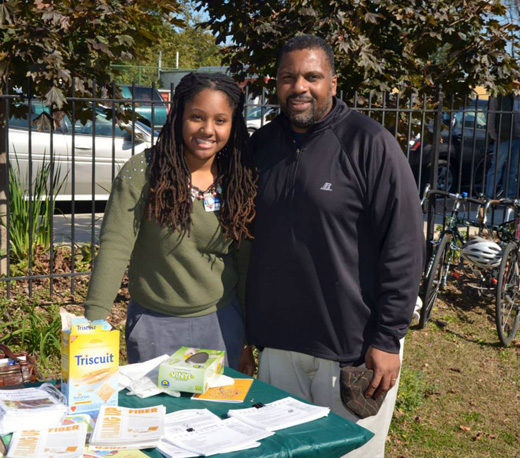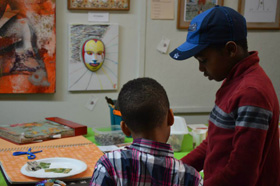 JASTECH development services executive director Jerome Shabazz (right), with Penn State Extension Nutrition Educator Simran James
JASTECH development services executive director Jerome Shabazz (right), with Penn State Extension Nutrition Educator Simran James
Pacing through the crowd of people sampling vegan dishes and checking out booths from groups like Philadelphia Backyard Chickens, Healthy Foods, Green Spaces and Eastwick Friends and Neighbors Coalition, Jerome Shabazz seems both busy and content. It’s a festival day at the Overbrook Art and Environmental Education Center (OAEEC), and the turnout is robust.
Shabazz organized the event, and he is especially excited because it marks the unveiling of “Growing Healthy Communities: A Prescription for Better Health,” a new OAEEC initiative that seeks to improve the neighborhood’s health, not with medicine, but with lifestyle changes. Employees from Lankenau Medical Center, located a mile away, performed health screenings at the event as attendees soaked in live music.
 Ali Shabazz (right) and Alexander Harrison receiving art instruction at the festival
Ali Shabazz (right) and Alexander Harrison receiving art instruction at the festival
“There are people in this neighborhood who have clearly defined health issues that can be remediated through passive methods like increased nutritional literacy [and] access to whole, healthy foods, as well as more movement and exercise,” says Shabazz, who is director of development services for Juveniles Active in Science and Technology (JASTECH), the nonprofit that runs OAEEC. “The idea with Prescription for Better Health is that health care practitioners give the prescription for what people need, but we fill it. So, when folks want exercise, we have classes from yoga to Zumba. We have whole foods available at the Common Market and from [OAEEC’s] greenhouse. We have food literacy programs and nutrition programs.”
Shabazz calls the work with Lankenau an “organic response” to local health issues. “They see that patients with a high incidence of hypertension and diabetes are in [local] ZIP codes, and it just happens to be a catchment area that we overlay with,” Shabazz says. “The initial part of this project is that there are identified patients who have hypertension and diabetes who will have access to the resources that are in their neighborhood via the Overbrook center around nutrition and healthy food access.”
 Philadelphia Orchard Project board member Brian Olszak works the cider press
Philadelphia Orchard Project board member Brian Olszak works the cider press
Making the relationship with local patients a success will depend on getting people comfortable with ideas like buying, eating and even growing their own healthy food, according to Shabazz. “One of the hardest things to do is change a behavior,” Shabazz says. “And when a clinical person diagnoses a need for you, that’s not necessarily connected to your daily habits, it’s something you do out of necessity. What is being experienced today is a natural remedy.”
Shabazz knows something about healing in his community. “[OAEEC] was a brown field site that had 20 tons of trash and debris on it less than six years ago,” he says. “So when I look back to that reality, the fact that we are here is amazing. We were able to repurpose this place to allow people to do what you see today. It’s hundreds of people from all walks of life coming together.”
Story by Brian Rademaekers








